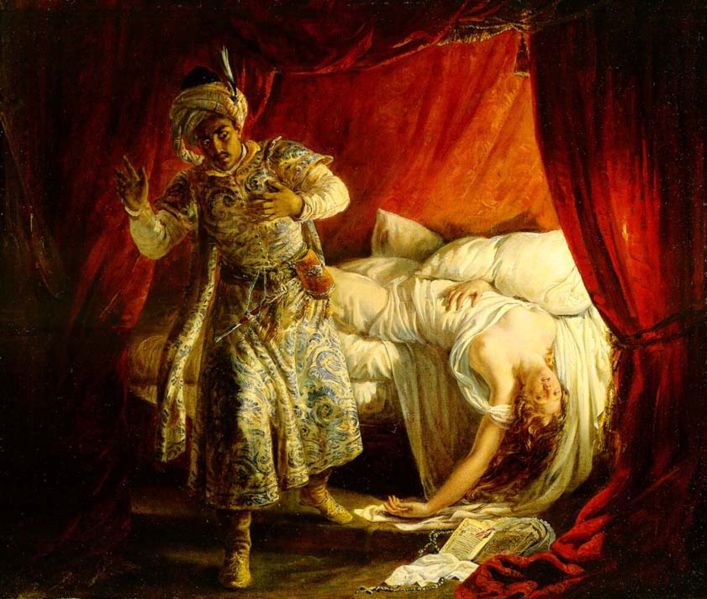It’s your classic love pentagon.
Watching Othello:
The audience believes that…
Iago wants…
Othello to believe that…
Desdemona loves Cassio…
Who loves her right back.
Evolutionary psychologist Professor Robin Dunbar calls the process by which we as human beings understand the hidden motivations and thoughts of others ‘intentionality’. This example from Othello is fifth level intentionality – that is, five layers of social understanding. The ability to think in this way is one of the main things that separate us from the apes. Human beings function in societies that are far larger and more complex than other primates (though not as large as you might think – ‘Dunbar’s number’ posits that you can only sustain 150 meaningful relationships in your life, a figure that has remained constant even in the age of Facebook).
This is possible because we have developed abnormally large brains with the considerable computing power needed to sustain social networks. If you’ve ever wondered why human babies are so utterly useless compared to the get-up-and-go offspring of other animals, it’s because we’re all essentially born 12 months premature. We’ve evolved such gigantic heads (really nothing more than pretty brain cases) that human babies have to be evacuated unfinished at 9 months, otherwise they’d be stuck forever. The rest of a baby’s development has to be finished off outside the womb. So this explains why my 6 months old nephew is such a tough crowd.
Another consequence of this is that we are capable of fifth order intentionality, whereas monkeys only manage first order (“they know that they know” to quote Dunbar) and some apes possess second order intentionality (“they know that someone else knows something”). Where this becomes crucial for the development of human culture is that it’s necessary to have at least third order intentionality to tell even simple narratives (where the teller communicates to the audience that someone else did something), and four levels are required to elevate this to the level of literature (‘‘the writer wants the reader to believe that character A thinks that character B intends to do something’’).
Dunbar argues that literature is at its most fascinating when it operates on the level of fifth order intentionality – as in the example from Othello. But here’s the catch. In order for Shakespeare to be able to write stories on the fifth level, he, as the weaver of this tangled web, had to be operating on the sixth level of intentionality – ie “I want the audience to believe that Iago wants Othello to believe that Desdemona loves Cassio, who loves her right back”. The ability to do this makes Shakespeare very unusual. Less than 20% of people are able to operate on this level, and this, says Dunbar, is one of the reasons why anyone can appreciate a great story, but it takes a brain like Shakespeare’s to write one.
Though rationalising Shakespeare’s storytelling gift like this might seem to some to diminish it, to me it only adds to its lustre. Though Shakespeare (and other great writers like him) were not, of course, aware of these theories, his innate understanding of what it is to be human meant that his writing intuitively reflected these principles. Further research showed that Shakespeare limited his dramatic setups to stay below the limit of intentionality that most people can comfortably grasp, to the extent that if a couple of offstage characters are being discussed, Shakespeare drops the amount of characters onstage to preserve fifth level intentionality. Other scientists have noted that Shakespeare’s plays have an average of 28 characters – the same size as the intimate inner circles human beings tend to form.
There’s one final evolutionary insight that culture vultures might find sobering. In primate societies, the key method of social bonding is grooming. It’s why monkeys can so often be found picking at each other’s fur. This serves no practical purpose, but it does release endorphins in the brain and help monkeys feel close to one another. Turns out the same works for humans, with MRI scanners showing endorphins flooding into the brain when we’re stroked lightly. The problem is, with our larger social groups, if we bonded in this way we’d have to spend nearly half of our day stroking each other. Pleasant as this sounds, it wouldn’t leave much time for building pyramids or conquering the world or writing theatre blogs, or any of the other things that make us as human beings such advanced creatures. In fact, we spend only around 20% of our day on social bonding, and Dunbar thinks it’s culture that bridges this gap. As a shortcut to social bonding, we’ve created religion, we make art and music and dance in unison, and most crucially we laugh together. Our artists conjure rich social experiences that glue our complex societies together.
So next time you see some Shakespeare and are tempted to feel a little smug over the fancy fifth level intentionality you’re operating on, remember that, in evolutionary terms at least, you’re just picking fleas out of the other monkeys’ fur…
I saw Professor Dunbar give a talk at the Royal Institution. Check their website for a fascinating lineup of events, held in the theatre where they film the Christmas Lecture – GEEKFEST!









